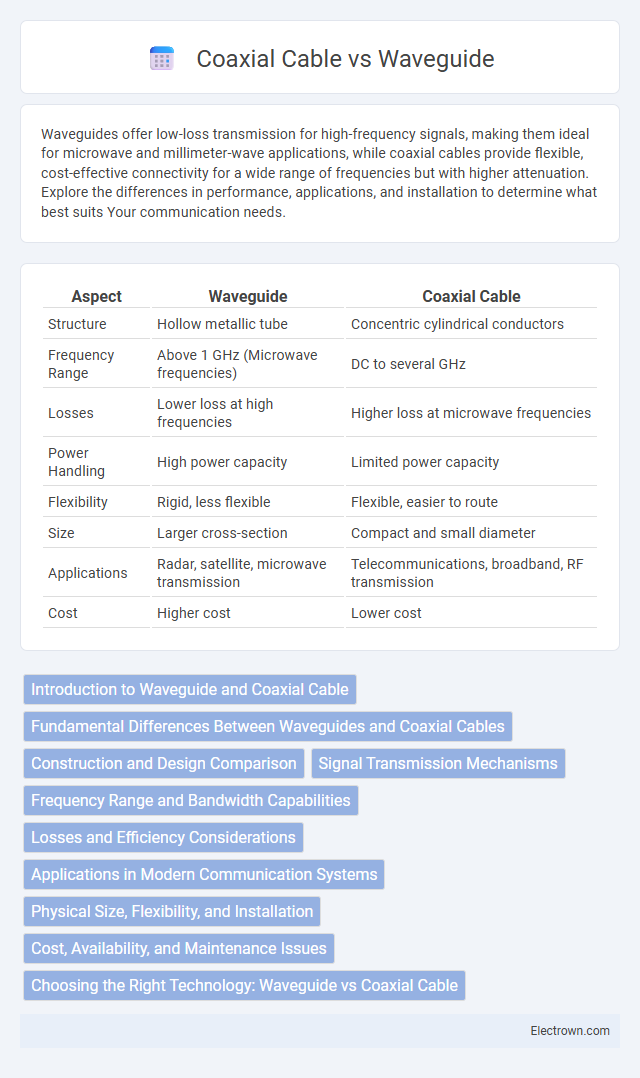Waveguides offer low-loss transmission for high-frequency signals, making them ideal for microwave and millimeter-wave applications, while coaxial cables provide flexible, cost-effective connectivity for a wide range of frequencies but with higher attenuation. Explore the differences in performance, applications, and installation to determine what best suits Your communication needs.
Table of Comparison
| Aspect | Waveguide | Coaxial Cable |
|---|---|---|
| Structure | Hollow metallic tube | Concentric cylindrical conductors |
| Frequency Range | Above 1 GHz (Microwave frequencies) | DC to several GHz |
| Losses | Lower loss at high frequencies | Higher loss at microwave frequencies |
| Power Handling | High power capacity | Limited power capacity |
| Flexibility | Rigid, less flexible | Flexible, easier to route |
| Size | Larger cross-section | Compact and small diameter |
| Applications | Radar, satellite, microwave transmission | Telecommunications, broadband, RF transmission |
| Cost | Higher cost | Lower cost |
Introduction to Waveguide and Coaxial Cable
Waveguides are hollow metallic structures that guide high-frequency electromagnetic waves, primarily used in microwave transmission due to their low loss and high power handling capabilities. Coaxial cables consist of a central conductor surrounded by an insulating layer and an outer conductive shield, widely employed for lower frequency signals and applications like cable television and internet connectivity. Both waveguides and coaxial cables serve as crucial transmission mediums but differ significantly in operating frequency ranges, physical structure, and signal attenuation characteristics.
Fundamental Differences Between Waveguides and Coaxial Cables
Waveguides and coaxial cables differ fundamentally in their structure and signal transmission methods; waveguides are hollow metallic tubes guiding electromagnetic waves primarily at microwave and millimeter wave frequencies, while coaxial cables use a central conductor surrounded by an insulating layer and outer shield to transmit electrical signals. Waveguides exhibit lower signal loss at high frequencies and support higher power handling capacity compared to coaxial cables, which are more flexible and easier to install for lower frequency applications. The choice between waveguide and coaxial cable depends on frequency range, power requirements, and environmental considerations in high-frequency communication systems.
Construction and Design Comparison
Waveguides are hollow metallic tubes designed to guide electromagnetic waves with minimal loss, typically used at microwave and higher frequencies, while coaxial cables consist of a central conductor surrounded by an insulating layer and an outer conductive shield for signal transmission at lower frequencies. The rigid structure of waveguides provides superior power handling and reduced interference, whereas the flexible design of coaxial cables allows easier installation and mechanical durability. Your choice depends on frequency range, power levels, and installation environment requirements.
Signal Transmission Mechanisms
Waveguides transmit signals using guided electromagnetic waves confined within a hollow metallic structure, minimizing energy loss at high frequencies, especially in microwave and millimeter-wave applications. Coaxial cables carry signals through a central conductor surrounded by an insulating layer and an outer conductive shield, supporting transverse electromagnetic (TEM) wave propagation ideal for lower-frequency signals. Understanding these distinct signal transmission mechanisms helps you choose the optimal medium for efficient and reliable communication.
Frequency Range and Bandwidth Capabilities
Waveguides excel in high-frequency applications, typically operating efficiently in the microwave range from 1 GHz to over 100 GHz, offering extremely wide bandwidth capabilities ideal for radar and satellite communications. Coaxial cables operate effectively over a broader range including low frequencies up to several gigahertz but experience increased signal loss and limited bandwidth above 10 GHz. The superior low-loss transmission and high power handling of waveguides make them preferable for ultra-high-frequency signals where coaxial cables fall short.
Losses and Efficiency Considerations
Waveguides exhibit lower signal losses compared to coaxial cables, especially at higher frequencies above 10 GHz, due to their hollow structure minimizing dielectric losses. Coaxial cables suffer from resistive and dielectric losses, which increase significantly with frequency, reducing overall transmission efficiency. Efficiency in waveguides remains higher for high-power and long-distance applications, while coaxial cables are preferred for lower frequency and shorter distance uses due to flexibility and ease of installation.
Applications in Modern Communication Systems
Waveguides are primarily used in microwave and millimeter-wave communication systems, such as satellite links, radar, and 5G networks, due to their low loss and high-frequency handling capabilities. Coaxial cables remain prevalent in broadband internet, cable television, and lower frequency RF applications because of their flexibility and ease of installation. Modern communication systems often integrate both technologies to optimize signal transmission across different frequency ranges and application requirements.
Physical Size, Flexibility, and Installation
Waveguides are typically larger and more rigid than coaxial cables, making them less flexible and more challenging to install in tight spaces. Coaxial cables offer greater flexibility and easier handling, which simplifies installation in complex or confined environments. Your choice between waveguide and coaxial cable should consider the trade-off between waveguide's low loss at high frequencies and coaxial cable's convenience in installation and flexibility.
Cost, Availability, and Maintenance Issues
Waveguides typically incur higher initial costs and are less widely available compared to coaxial cables, which are more cost-effective and readily accessible for most applications. Maintenance of waveguides can be complex due to their rigid structure and susceptibility to physical alignment issues, whereas coaxial cables are easier to maintain and repair, benefiting from flexible design and widespread industry familiarity. The choice between the two often hinges on budget constraints, availability in specific frequency ranges, and the required maintenance infrastructure.
Choosing the Right Technology: Waveguide vs Coaxial Cable
Waveguides offer superior performance in high-frequency applications above 6 GHz, providing lower loss and higher power handling compared to coaxial cables, which are more suitable for frequencies below 6 GHz due to their flexibility and ease of installation. Selecting between waveguide and coaxial cable depends on factors such as operating frequency, signal attenuation, power requirements, and mechanical considerations. Waveguides are preferred in radar, microwave, and satellite systems where efficiency and minimal signal loss are critical, while coaxial cables remain ideal for general-purpose RF transmission and lower frequency communications.
Waveguide vs Coaxial Cable Infographic

 electrown.com
electrown.com